Climate solutions
Climate change is one of the most pressing challenges that humanity faces. In the Paris agreement, all countries committed themselves to limit the global warming to well below 2°C, aiming for below 1.5°C. Achieving these climate targets requires rapid and complete decarbonization as well as the development and implementation of reliable Carbon Dioxide Removal (CDR) technologies that capture atmospheric CO2 and ensure its long-term sequestration (Figure 1).
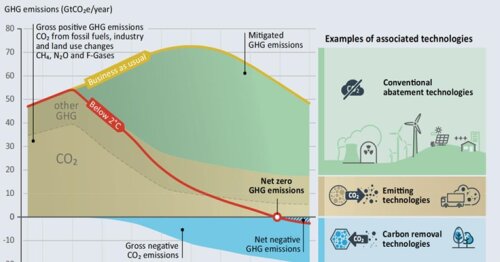
Figure 1: Besides rapid decarbonization with conventional technologies, also CDR technologies are necessary to limit warming to well below 2°C, as determined by the Paris Climate Agreement [1].
Safe and scalable CDR technologies will be needed to remove CO2 from the atmosphere. In SUSTAIN, we investigate nature-based CDR technologies that have the potential for generating co-benefits for the environment and for society. These are: enhanced silicate weathering, biochar addition and soil carbon sequestration.
- Enhanced silicate weathering (ESW) involves the reaction of silicate rock dust with CO2 and water, potentially sequestering carbon for millennia. This rock dust can be applied on agricultural soils, where it may yield co-benefits such as increased crop growth. See below for more information.
- Biochar is derived from the thermal combustion of biomass (e.g. agricultural waste) under low oxygen conditions. Biochar has a high and stable carbon content, making it an effective CDR technology; it serves as a long-term carbon sink when incorporated into the soil. Moreover, biochar also enhances soil health and fertility through its structure, high cation exchange capacity and large surface area
- Multiple agricultural practices can increase soil organic carbon content, ranging from reducing tillage to growing deep-rooted cover crops. Additionally, the incorporation of organic matter into the soil is a key component of soil carbon sequestration. This not only enriches soil health and fertility by acting as a reservoir of nutrients but also plays a critical role in enhancing the soil water retention and drainage capacity.
Last, we also study how climate affects terrestrial carbon and nutrient cycling. Through experiments and database analyses, we examine for example how warming, drought and other environmental factors influence plant growth and how these effects are steered by nutrient availability. Recently, we published a comprehensive database of global change manipulation experiments. This database is freely accessible at doi.org/10.5281/zenodo.7153253 [2].
Enhanced silicate weathering
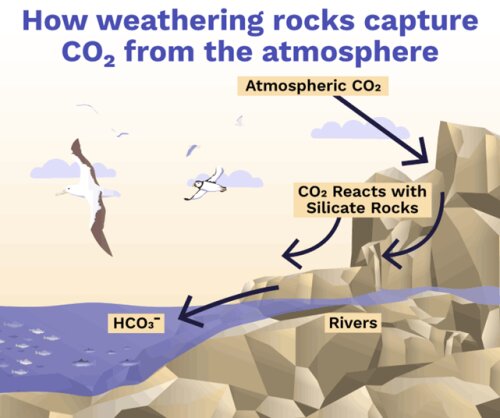
Figure 2: Atmospheric CO2 dissolves in rainwater and forms carbonic acid (H2CO3) which in turn reacts with silicate rocks to form bicarbonate (HCO3-) and release cations from the minerals. These elements can find their way to oceans through groundwater and rivers [3].
Natural silicate rock weathering results in bicarbonate formation, which ultimately reaches the oceans, where it becomes part of marine carbonates that sequester carbon for millennia (Figure 2). This natural process can be accelerated by grinding rocks to increase the surface area and spreading the silicate rock powder over suitable lands.
Thus far, knowledge of ESW has been mainly gained through experiments that focused on the abiotic variables, thereby neglecting the potential influence of biotic components. While plants, bacteria, fungi, and earthworms are known to increase mineral weathering rates (Figure 3), the use of soil organisms in the context of ESW remains underexplored.
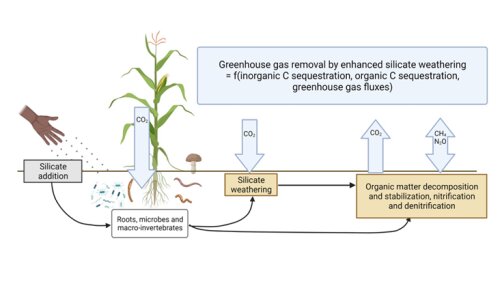
Figure 3: Silicate weathering has a strong interaction with present biota and soil physiochemical properties. ESW applications might have direct and indirect effects on organic matter decomposition and stabilization as well as greenhouse gas emissions [4].
Several of our research projects investigate ESW and its interactions with biota, including crop plants, earthworms, fungi, and bacteria in agricultural setups (Figure 4). We monitor silicate weathering indicators to follow the rate of inorganic carbon sequestration as well as the changes in soil greenhouse gas fluxes, such as CO2, CH4, and NO2 (Figure 5). We also examine the dynamics of soil organic matter turnover and resilience due to ESW application and biological diversity. This way, we aim to improve our understanding of the climate impact of ESW.
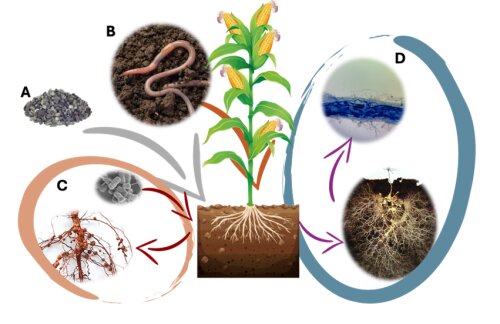
Figure 4. We investigate the interactions of silicate amendment (A) with earthworms (B), root colonizing bacteria [5, 6] (C), and mycorrhizal fungi (D).
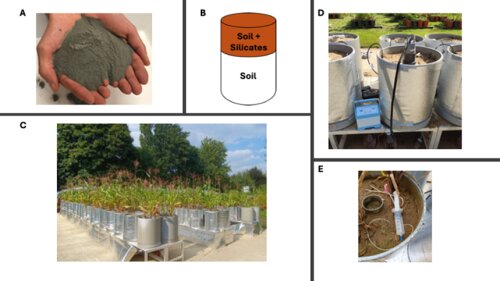
Figure 5. In mesocosm experiments, we mix ground silicate material (A) with topsoil in pots (B) where we grow crop plants (C). Throughout the experiments, we monitor greenhouse gas emissions (D) and silicate weathering dynamics (E) to understand the climate mitigation potential of ESW and its effects the crops.
In the C-Farms project (FWO-SBO), we also investigate ESW in combination with addition of biochar and organic matter (e.g. compost). Here, we deploy agro-experiments in combination with environmental, techno-economic and social impact assessments, steered by a participatory process. We investigate how current agricultural practices can be adapted to increase CO2 removal, while taking into account economic viability and maximizing ecosystem services to society.
Besides applications in agriculture, we also investigate the stimulation of ESW in a multiphase hybrid reactor in the EIC project BAM. BAM combines research into the effects of bacteria, fungi, and earthworms on ESW with high-frequency data collection and AI-based machine learning analysis to determine optimal conditions for maximizing carbon sequestration.
References
1- UN Emissions Gap Report 2017
2- Van Sundert, Kevin, et al. “When Things Get MESI: The Manipulation Experiments Synthesis Initiative—A Coordinated Effort to Synthesize Terrestrial Global Change Experiments.” Global Change Biology, vol. 29, no. 7, Jan. 2023, pp. 1922–38. https://doi.org/10.1111/gcb.16585.
3- climatescience.org
4- Vicca, Sara, et al. “Is the climate change mitigation effect of enhanced silicate weathering governed by biological processes?” Global Change Biology, vol. 28, no. 3, Nov. 2021. https://doi.org/10.1111/gcb.15993.
5- Zweers, Jessica C., et al. “Towards the Development of Bacillus Subtilis as a Cell Factory for Membrane Proteins and Protein Complexes.” Microbial Cell Factories, vol. 7, no. 1, Apr. 2008, https://doi.org/10.1186/1475-2859-7-10.
6- Gouda, Sushanto, et al. “Revitalization of Plant Growth Promoting Rhizobacteria for Sustainable Development in Agriculture.” Microbiological Research, vol. 206, Jan. 2018, pp. 131–40. https://doi.org/10.1016/j.micres.2017.08.016.